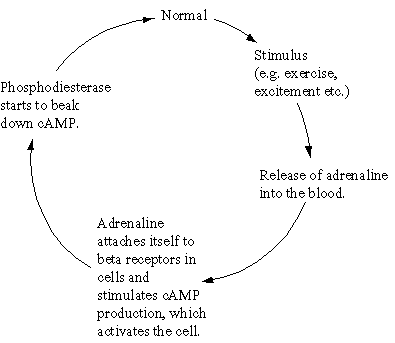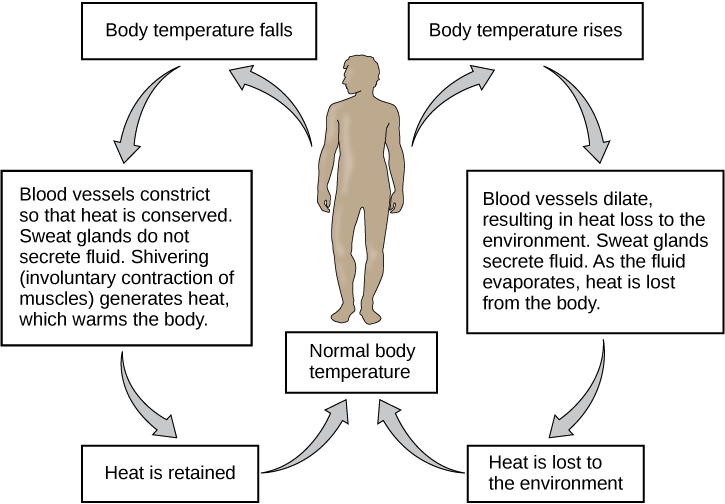Control Systems
Table of Contents
- The Nervous System
- Endocrine system
- Compare and Contrast: The endocrine system and the nervous system
Hey there! Please be advised if you’re an boi this doesn’t exactly match your textbook! I’ve tried to keep similar concepts together so if you can’t find something, feel free to use the textbook, or use that neat little search bar up the top there! Thanks!
This section contains limited information, and is based off the Y9 Aloys Final exam for 2019.
The Nervous System
The nervous system controls and coordinates your body. It is divided into two parts:
- Central nervous system (brain and spinal cord)
- Peripheral nervous system (nerves that connect the CNS to the rest of the body)
Either electrical or chemical nerve impulses can occur.
Stimulus, Receptor, Response!
The first step to initiating a response is having a stimulus.
A stimulus can be anything which triggers an action, including:
- Seeing a chainsaw thrown at you by Oscar
- Hearing the teacher coming towards you while you’re playing video games in class
- Seeing a freezer full of chocolate
This stimulus is received by a receptors. Examples of receptors include:
| Type of receptor | Stimulus these receptors respond to | Example of places where these are found |
|---|---|---|
| Chemoreceptors | Chemicals | Tongue |
| Photoreceptors | Light | Eye |
| Mechanoreceptors | Pressure or distortion | Skin, inner ear |
| Thermoreceptors | Heat | Skin |
Different types of receptor cells do different things.
The Structure of the Neuron
A neuron is a long cell containing:
- a cell body and a nucleus which supplies energy and nutrients to the neuron
- dendrites which are branches that receive nerve impulses from receptors and other receptors
- axons which are long structures that nerve impulses pass along. Electrical signals travelling along are insulated by myelin
- axon branches at the end of each axon that send nerve impulses to other neurons or effectors
Direction of travel:
Dendrite ––––––––––––––––> Axon Branch
The three types of neurons
- Sensory neurons: stimulus to CNS
- Interneurons: CNS
- Motor neurons: CNS to effectors (e.g muscles, glands)

Sensory neurons are pseudounipolar (axon with two extensions – one to receive info and other to transmit to spinal cord).
Interneurons and motor neurons are multipolar (one axon and many dendrites) so that lots of information can flow through.
Other neuron structures not mentioned in the above 3 neurons include unipolar and bipolar neurons.
Neurotransmitters and Synapses

To continue relaying a nerve impulse across different neurons, chemical compounds called neurotransmitters are used.
The gap between neurons are called synapses.
When a nerve impulse reaches the axon (presynaptic) terminal, then neurotransmitters are released into the synapse. This is because a nerve impulse activates voltage gates which lets Ca²⁺ from outside the neuron rushes inside to the neuron (where the Ca²⁺ concentration is fewer.)
Then, this triggers synaptic vesicles (which store neurotransmitters) release transmitters. At the dendrite of the postsynaptic cell the neurotransmitters bind to receptor proteins. This in turn will open or close ion channels (either causing it to become overall more negative (depolarising) or positive (hyperpolarising)).
Did you get that?
In a nutshell:
- Gaps between neurons are synapses
- Nerve impulse reaches presynaptic axon terminal and neurotransmitters are released
- Postsynaptic dendrite receives neuron, causing cell to fire and relay the nerve impulse
Reflex arc
When reflex acions occur, no conscious thought is required. Reflex arcs are actions that are carried out quickly.

The Structure of the Brain
- Protected within a skull
- Covered with meninges; three layers of protective tissue that surrounds the brain and spinal cord
- Covered with cerebral fluid; fluid surrounding the brain under the meninges
The brain consists of three main sections:
- Cerebrum: largest part of the brain (90%) and made up of two hemispheres that control memory, speech, thought. Conscious thought!
- Cerebellum: between the cerebrum and brainstem and controls balance and muscle
- Brain stem (medulla): connected to spinal cord and controls breathing, heartbeat, digestion

Stem cells
Stem cells are cells that can develop into other specialised cells. They can be used in some cases to regrow damaged nerve cells.
The Structure of the Eye
This section is basically ripped off the textbook.
The eye is made up of a number of different components.
/GettyImages-695204442-b9320f82932c49bcac765167b95f4af6.jpg)
- The cornea is the clear, curved, outer surface of the eye
- It is curved so light approaching the eye is refracted towards the pupil
- The lens is a clear, flexible tissue located behind the iris and the pupil
- It focuses light onto the retina
-
The retina is a curved surface at the very back of the eye, which is lined with photoreceptors. The photoreceptors respond to light by sending signals to the optic nerve, which in turn sends signals to the brain in the CNS
- Short sightedness and long-sightedness occurs when light doesn’t focus on the retina properly
Endocrine system
Human endocrine system on BBC Bitesize
Hormones are produced by glands in the endocrine system, and carried in the bloodstream. Hormones alter activity of target organs (organs with receptor molecules on cell surfaces that recognise a specific hormone). They differ from the nervous system as effects are slower but longer lasting.
For example, adrenaline produced in the adrenal glands target several organs in the respiratory and circulatory system. This is the ‘fight or flight’ reflex that can increase breathing and heart rate, and convert glycogen to glucose.
When conditions are constant and carefully controlled, we call this homeostasis. For example body temperature, blood glucose levels and pH levels remain relatively stable.
Insulin
Insulin is produced in the pancreas. Insulin is then carried through the bloodstream to the liver to regulate glucose levels in the blood. This then causes conversion of glucose into glycogen (for storage). Remember that glucose = sugar.
Thyroid
The thyroid gland produces thyroxine which regulates metabolism, heartbeat and body temperature. If there is too much thyroxine then body temperature rises.
Negative Feedback Loop
A negative feedback loop is a mechanism to lower raised levels of something, and then to raise reduced levels of something, continuously.
Negative feedback is when a change in the body is detected, a message is sent to a gland or organ, and a response is initiated.
Positive feedback, however, is when a change in the normal state is amplified. For example, when the brain is stimulated to create more oxytocin (for example during labour), it induces contractions which in turn release postaglandins. And then, more oxytocin is released. Stretch receptors no longer fire once the baby is out of the womb, and no more oxytocin levels are produced.
Caffiene Negative Feedback Loop

Blood Glucose Negative Feedback Loop

Body Temperature Negative Feedback Loop

- A Air temperature increases.
- B Heat receptors detect increase in temperature and send message to the hypothalamus in the brain. Message travels along nerve cells.
- C Hypothalamus sends messages to sweat glands and walls of capillaries close to the skin.
- D Capillaries close to the skin dilate and heat radiates from the skin surface.
- E Sweat production increases. Heat is lost as sweat evaporates from the skin.
- F Temperature returns to normal. Messages from hypothalamus cease and cooling responses are turned off.
- G Air temperature decreases.
- H Heat receptors detect decrease in temperature and send message to the hypothalamus in the brain. Message travels along nerve cells.
- I Hypothalamus sends messages to muscles and walls of capillaries close to the skin.
- J Capillaries close to skin contract. Less heat radiates from skin.
- K Muscles shiver, generating heat.
- L Temperature returns to normal. Messages from hypothalamus cease and warming responses are turned off.
Where are the glands in the Endocrine system located?
The endocrine system consists of a number of different glands.
Reproduction
Hormones control the menstrual cycle in women and sperm production in men. The hormone oestrogen and progesterone are associated with menstruation.
- During menstruation, oestrogen and progesterone levels are low.
- Before childbirth, progesterone levels are low.
- After menstruation, oestrogen levels rise.
- After ovulation, progesterone levels rise.
- During puberty, increased levels of oestrogen in women and testosterone in men cause secondary sex characteristics such as changed body structure, growth spurts, and more hair. Ew.
Love is in the air
- In animal species, pheromones are released when they are ready for mating.
- This releases a distinctive smell in the air.
- Oxytocin is released when you cuddle people.
- It helps humans develop bonds with each other.
Compare and Contrast: The endocrine system and the nervous system
How the Nervous System Interacts with Other Body Systems - University of Washington
- The endocrine system uses chemicals to affect changes in the body
- It makes slower but longer lasting changes to target organs
- The nervous system uses electrical signals (and sometimes chemical signals) to affect changes in the body
- Changes are more immediate but are shorter lasting
- The nervous system is codependent with the endocrine system
- Reproductive hormones can affect the development of the nervous system
- The hypothalamus at the base of the brain controls the pituitary gland, which controls most other glands